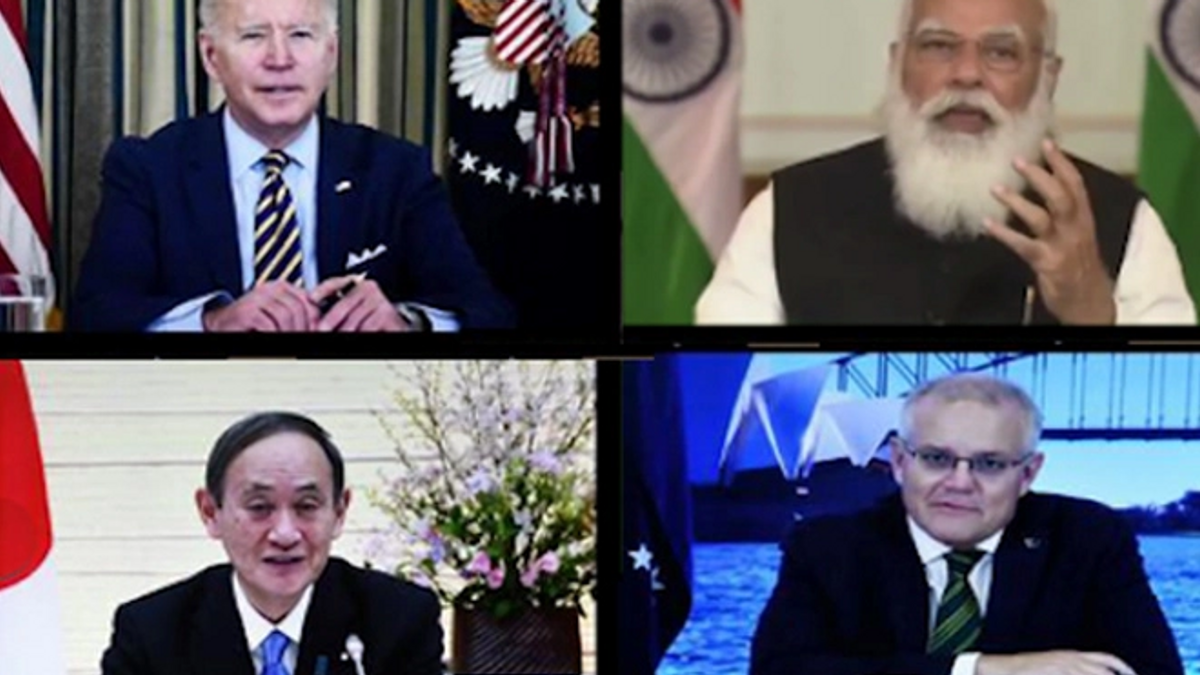
The Limping QUAD : How will it shape-up?
Post Tsunami in 2004-05, four nations namely India, USA, Japan and Australia coordinated the relief response that was given a name of QUAD (the Quadrilateral Security Dialogue) of the four democracies. In 2007, Japan conceptualized it as a possible formidable group. It started an informal strategic dialogue with a shared objective to ensure and support a “free, open and prosperous” Indo-Pacific region. However, owing to the reluctance of one or the other partners due to various reasons, the formalization of the group remained in limbo till the time the dragon started posing multiple threats…to India, Japan, Australia and worst, the USA in the pacific. The first informal meeting of the Quad foreign ministers took place in Japan in 2019 as a group showing its first resolve to confront China in the South China Sea (SCS). Thereafter, some progress took place in shaping up the policies after which a virtual summit meeting of the leaders of the four nation took place in March 2021, with a strong emphasis to make the Indo-pacific a safer place for international maritime passage. However, no formal security alliance has taken shape as yet.
Actually, Japan has been showing its hesitance in words because of their trade related economic dependence on China. India too has very little stake in the SCS and the Pacific Ocean per se. The group came together in SCS as a composite force and Malacca Strait in 2020. The Malabar exercises could be a pointer to it. However, it did not address the US concerns in the deep Pacific which is rather too far for India and too much of an ask for Japan. Although it is bit too far for UK too but the British has been showing their intent to join in any Pacific Ocean military security alliance. Hence, one that UK is part of NATO and secondly its intent to join a military alliance, is possibly the reason why Australia, United Kingdom and the USA formed the military alliance “AUKUS” signed just few weeks before the QUAD summit in USA. This of course raises some doubts on the fate of QUAD as a formidable Security Alliance. It will be worthwhile examining why China is posing its hegemony in the region.
Immediately after the break-down of the USSR, China has been aspiring to become the world power. A superpower is the one that has the might to do what it wants. Such mights are of military and economic strengths added with a leadership role at international fora like the UNSC. Today China has second largest GDP in the world with huge surplus of the funds. There is absolutely no doubt that Chinese economic might is gradually transforming to its military might. It has the largest fleet of naval warships in quantity, not necessarily in quality though. Its Air power has also grown and so is the military power. All these are translating in to Chinese arrogance in the South China Sea (SCS) threatening all other stakes holders namely Vietnam, Cambodia, Malaysia, Indonesia, Philippines, Brunei and Taiwan.
Immediately after their independence in 1949, the Chinese started their expansionist agenda in to Tibet, Xinjiang, Mongolia as well as in to the SCS to unlawfully acclaim some of the smaller islands of Paracel, Pratas, Zhongsha and Spratly, to expand it artificially so as to utilize as military bases. It drew nine dotted line in the SCS claiming it to be own and to debar the all other stakes holders from exploiting its resources. It was an arbitrary action against UN conventions and laws of the sea (UNCLOS) as shown in the shaded area.
Hence, Philippines filed a case in the International court of justice (ICJ) which ruled it in its favour in 2016. However, Chinese hegemony continued and they openly expressed their disregard to the ruling and threatened all regional nations. Apprehending reprisal in the hands of the Chinese, those nations chose to refrain from raising the issue in exchange for some economic cooperation and soft loans. This provided China with an excellent opportunity to rule the entire international waters of the SCS imposing both marine and airspace restriction to anyone entering the waters. In the region, almost all nations except Taiwan, India and Vietnam had submitted to the Chinese will. Taiwan is already in Chinese threat of invasion. China is also trying to expand in East China sea as well as in Ladakh bordering India. This emboldened China to venture a step further to threaten the securities of US navy and their Guam island base in the Pacific Sea. These were the events that angered the USA which decided to take the bull by its horns and did it successfully too. Two US naval fleets USS Nimitz and Ronald Reagan with aircraft carrier was positioned in the SCS. USA also now mooted for the QUAD group to come strong so as to ensure uninterrupted passage in the international waters in the SCS.
Looking at the QUAD with their military resolve, Philippines, Vietnam and Malaysia have started raising their voices for the Chinese to obey the ULCLOS in the SCS. The composite effort of all nations have made China to realise that it is surrounded from all sides and no longer can afford to do anything other than issuing empty threats. China has been at unease with the concept of QUAD esp in the last few years. It will be worthwhile examining the interests of the stakes holders in the Quad group.
USA has three basic concerns against the Chinese in the SCS. Firstly, there should be no threat to its assets in the Pacific and Indo-Pacific Ocean. Secondly, there should be no threat to the interest of its allies namely Japan, Taiwan and the Philippines. Thirdly, no one should restrict the maritime interest of the world in the international waters of the SCS. Japan has own interest of endangered security to main land as well as some of its far-flung islands threatened by China. Australia has both economic and maritime defence interest of free passage through the SCS. India has dual concerns of maritime free passage through SCS as well as restricting the Chinese expansionism elsewhere esp in Ladakh and along the Line of Actual Control (LAC). The smaller stakes holders in the region only want their legitimate maritime rights under UNCLOS that has been severely challenged or curtailed by the 9 dotted lines of China.
On the military front, China’s territorial expansionist ideology has back fired. India has thwarted Chinese attempts of intrusion in east Ladakh. Their hegemony in South China sea has been severely challenged both diplomatically in the UN as well as by the Quad Group in exercising their marine security and cooperation. In all, the Chinese may have to wind-up their military deployments on some of the artificial islands posing direct threats to the vessels in the international waters of the SCS. There is also a serious challenge to Chinese access to the Indo-pacific because of its vulnerability in the Malacca strait. By now, almost all ASEAN nations are against the Chinese hegemony in the SCS that will seriously hurt exploitation of their own marine resources in their own waters. Chinese brazen disregard to the ICJ ruling on SCS cannot be tolerated. This case is already in UN.
Time is come the Chinese have to be cut to their size and shown their rightful place in the world hierarchy. The AUKUS is the first military alliance that will forbid the dragon from any major misadventure in the pacific. The QUAD group is making the dragon realise this bitter truth. The summit meeting of the group scheduled for 24 Sep 21 in USA is expected to take a formal shape of semi-military or of purely economic nature. They will take a call on various burning issues with China that includes SCS, the Indo-Pacific Ocean security, economic cooperation and increasing Chinese Ciber Crimes. In the opinion of some of the Defence experts, it will be good if Taiwan, Vietnam, Philippines, Malaysia and Indonesia may also be incorporated as members in the near future, as they too have equal stakes in the SCS and will make the objectives of the group more meaningful. All eyes will be in the forthcoming meeting and the tone & tenor of their words.
